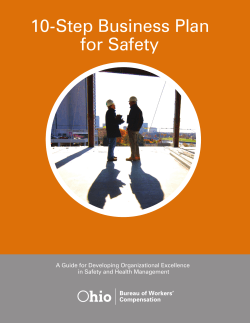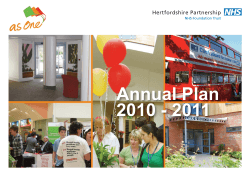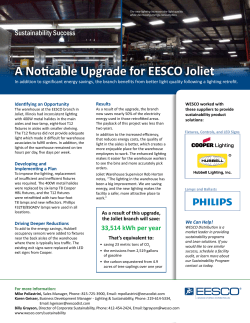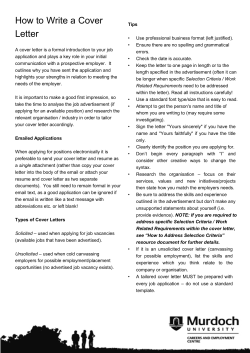
International Management Journals ������������������������������������������������ TQM Sustainability:
International Management Journals www.managementjournals.com �������������������� ������������������������������������������������ International Journal of Applied Strategic Management Volume 2 Issue 2 Special Edition Driving Strategy with Quality: A Useful Insight TQM Sustainability: What it means and how to make it viable A Viewpoint By Professor Mohamed Zairi Juran Chair in TQM Director of The ECTQM University of Bradford UK ISSN 1742-8204 www.managementjournals.com International Journal of Applied Strategic Management: Volume 2 Issue 2 The literature review indicates that in order to achieve ‘world-class’ status, each MBNQA and EQA winner had to closely examine its entire operations, processes and its customers, so as to compare itself with the best in class. Self-assessment, which is one of the fastest growing methods, is used by these organizations to measure their standards and performance in their attempts to achieve world class rating. Both the MBNQA and EQA models provide the ideal framework against which this can be done. Their TQM implementation evolved against a background of economic and business pressures that derived an increased focus on the continuous benchmarking of their performance with the world’s best, adapting new best practice and innovating to become world-class. A world-class organization is one that has the production and/or service capability that is competitive in the dynamic global economy. A synthesized review of the literature on the 1988 and 1999 MBNQA winners, also the 1992 and 1999 winners of the EQA examined the history and evolution of their TQM path and the findings reflect four paradigm shifts ( Table 1): 1988 (World Class) 1999 (World Class) Product Orientation Service orientation Customer Orientation Market Orientation Six Sigma Customer Service Customer Satisfaction Quality Management Statistical Variation Meas Service Delivery Customer Loyalty Customer Loyalty Cycle Time Reduction Responsiveness Customer Complaints Process Efficiency Quality Audits Customer Retention Supplier Management Customer Service Product Reliability Service Business Improv. Customer Service Customer Relationships Zero Defects Customer Satisfaction Innovation Innovation Continuous Improvement Process Mapping Responsiveness Responsiveness Cost Reduction Service Delivery Customer Partnership Employee Empowerment Quality Circles Employee Training/Skills Employee Training/Skills Policy Deployment Technology Quality Culture Quality Culture Benchmarking Customer Service Service Reliability Continuous Improvement Process Improvement Employee Incentive Flexible Job Assignment Quality Leadership Stakeholder Management Product Design Right First Time Flexible Job Assignment Continuous Improvement Flexible Job Assignment Continuous Improvement Right First Time Environmental Impact Employee Training/Skills Quality Leadership Process Improvement Societal Impact Quality Culture Customer Complaints Communications Quality Culture Quality Leadership Process Improvement Accountability Process Mapping Benchmarking Communications Service Reliability Quality Leadership Table 1: Evolution and History of TQM Path The aforementioned analysis was undertaken by Zairi & Liburd (2001) and they concluded that essentially TQM sustainability is alrgely dependent on the following: 1. A series of transformational change paradigms, through an evolutionary path reflecting a product, service, customer and market orientations.; 2. The existence of a number of critical factors which impinge greatly on TQM successful implementation and which enable superior performance; 3. The creation of a culture of continuous improvement, learning and innovation so as to have in place a sustainableclimate of growth; 4. An emphasis on measurement using a balanced perspective www.managementjournals.com Page 1 International Journal of Applied Strategic Management: Volume 2 Issue 2 The Meaning of TQM Sustainablity The concept of sustainable development has been touted as a new planning agenda (Beatley and Manning, 1998). As such, it becomes a fundamental concept which should be an important aspect of all further policy developments (Loffler, 1998). Sustainable development is based on a perceived need to address environmental deterioration and to maintain the vital functions of natural systems for the well being of present and future generations. Zairi (2001) defines sustainability as ‘the ability of an organisation to adapt to change in the business environment to capture contemporary best practice methods and to achieve and maintain superior competitive performance’. This concept implies that sustainability is a mean for an organisation to maintain its competitiveness. Quinn (2000) has similar idea on sustainability: ‘development that meets the present without compromising the ability of future generations to meet their own need’. Gladwin et al. (1995) defines it as “development, which meets the needs of the present, without compromising the ability of future organisations to meet their own needs”. Garvare and Isaksson (2001) define sustainable development as ‘the process to reach a steady state where both humanity and nature thrive’ (p12). To succeed with this, a global management process for sustainable development is needed and management processes are needed on the personal, organizational and societal levels. The reasons for pursuing sustainability are: morality, intergenerational equity, survival, and organizational benefits and risks. Sustainable performance Sustainability is crucial to company performance. The organisational goal describes where the organisation is headed based upon the business environment and consistent with the corporate vision. Mission statements are used by individual subbusiness units (e.g., distribute centres, manufacturing sites, specific operations or modules, etc.) to articulate how they contribute to the business unit’s vision. A mission statement defines the purpose of a business unit. Value statements are timeindependent principles that articulate how individuals in the organization are expected to behave as they pursue the vision and mission. Value statements can especially make an impact when the value represent changes in behaviour required for the organization to achieve its vision and deliver its mission. Measuring Performance through assessment of the organisation's vision and mission statements is the foundation of a sustainable effective performance measurement system (Hacker and Brotherton, 1998). Garvare and Isaksson (2001) suggest that many different concepts can be applied as measurements and indicators of sustainable development. They propose four categories of indicators divided as: 1. Driving forces; 2. State; 3. Reactive response; and 4. Active response. They argue that excellence for sustainable development can be built on the triangle ‘person-organization-society’. One way of doing this is to redefine stakeholder priorities. In other words, TQM effectiveness and organisational performance can be measured by using self-assessment framework of quality management, such as the European Quality Award (EFQM), Deming Prize (Japan), and the Malcolm Baldrige National Quality Award (Kunst and Lemmink.2000). Quality awards have also been established at the national and region framework for analysing different factors, such as processes, leadership, and personnel management and business results, which www.managementjournals.com Page 2 International Journal of Applied Strategic Management: Volume 2 Issue 2 play a role in the functioning of organisations. The criteria cover a wide range of subjects that are all relevant to quality performance in organisations (Dessler and Farrow, 1990). Awards are indeed strongly based on the foundations of TQM (Bemowski and Sullivan, 1992;Stauss, al levels (Harjono and Hes, 1993). Kunst and Lemmink (2000) believe that quality awards could be applied to both profit and nonprofit sector. Sustainability of TQM in an organisation is determined by the successful implementation of CSFs as proposed by the award criteria. How to make TQM Sustainable? Zairi & Liburd (2001), suggest a Model, referred to as the TQM Maturity and Sustainable Performance Model (TQM-MSPM). The Model is depicted in Figure 1, and essentially This TQM Maturity and Sustainable Performance Model is based on the premise that there is a need for creating an organizational system that fosters cooperation, learning and innovation in order to facilitate the implementation of process management practices. This in turn leads to continuous improvement of processes, products and services, and to employee fulfillment, both of which are critical to stakeholder satisfaction and ultimately to the survival of the organization. Implicit in this proposition is the crucial role that organizational leadership has to play in order to ensure the success of quality management. It is the responsibility of leaders to create and communicate a vision that moves the organization toward continuous improvement, also to be supportive, in order to enable the creation and sustenance of an organizational system that is receptive to process management practices. The key elements and logic of the Model, include the following: Driver – (Need for TQM) The “Driver” can be interpreted as the TQM approach to quality that exemplifies characteristics that an organization needs to display, to successfully compete in the market place. As a business imperative, it must re-establish itself to be quicker to market, customer-focused, innovative, flexible and better able to cope with rapid change. A summary of the key drivers that were identified in the literature include – work process improvement, positive work experience, customer focus and satisfaction, supplier relationships and performance, support services and competitive advantage. Stages of Evolution - (Paradigm Shift Required –Orientation) The stages of evolution encountered during the review of the literature, are in support of the proposed TQM model (Figure 1), it bears repeating that several pundits have advanced different definitions and concepts of quality. However, the reality of present day globalization is that markets have expanded in size, and the volume of activity in both manufacturing and service sectors has outgrown the capacity to manage by personal direction. With the emergence and growth of technology, products and processes have become increasingly complex when one considers the totality of environmental forces. www.managementjournals.com Page 3 International Journal of Applied Strategic Management: Volume 2 Issue 2 The concept of orientation implied in this model therefore reflects the degree and nature of the organization’s adaptation to a specific situation or environment in which it has to operate. It is thus suggested that the road to TQM requires a paradigm shift that takes into account the four significant transitional periods found in the literature: “Production, Service, Customer and Market Orientations”. Sustainable Performance – (Paradigm Shift required – Measures) TQM looks at quality as a long-term business strategy which strives to provide products and/or services to fully satisfy both the internal and external customers by meeting their explicit and implicit expectations. At the core, is the issue of measurement which is the source of strength, continuity and sustainable performance. The “Business Balanced Scorecard Approach” which is an overall method of tracking performance, forms an integral part of the proposed model. This concept helps to focus on both the qualitative and quantitative measures which are the main ethos of performance measurement. Learning and Innovation Incremental improvement is grounded in the literature on learning curves [Cochran, 1968; Dutton et al, 1984; Yelle, 1979]. These authors have proposed that extended production experience provides the employee with an opportunity for learning that may lead to a predictable decrease in the manufacturing cost per unit over time. Innovation is also integral to the concept of continuous improvement and to the proposition that visionary leadership enables the simultaneous creation of a cooperative and learning organization [Deming, 1986]. According to Deming, organizational learning generates and encompasses two types of knowledge – the process task knowledge akin to the “science of the process”, complete with the understanding of technology, human and task requirements as explicated with precise operational definitions that guide activity and the measurement of quality. Culture of Continuous Improvement The culture of continuous improvement in the context of the proposed model, means better and better quality, less and less variation which results from process management practices that bring forth incremental improvements and innovations in products, services and processes. The organization must be capable of adapting to changing opportunities and the requirements of all key stakeholders. Fact-based decisions must be made from the analysis of data collected from sources including – key customers, supplier and stakeholder interaction. These sources can only contribute to an effective communication system, that will enable the organization to become more flexible and responsive to changing needs, and to continuously improve business practices. www.managementjournals.com Page 4 International Journal of Applied Strategic Management: Volume 2 Issue 2 References Zairi, M. with Liburd, I.M. (2001), "TQM Sustainability - A Roadmap for Creating Competitive Advantage", Integrated Management, Proceedings of the 6th International Conference on ISO 9000 and TQM, University of Paisley, Ayr, Scotland, 17th - 19th April, Scotland, pp. 452 - 461, Published by Hong Kong Baptist University Press (ISBN 962-86107-2-4) www.managementjournals.com Page 5
© Copyright 2025





















